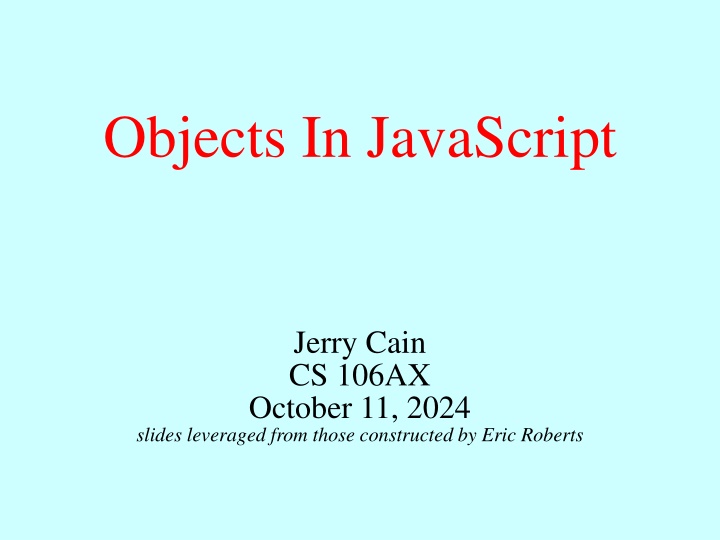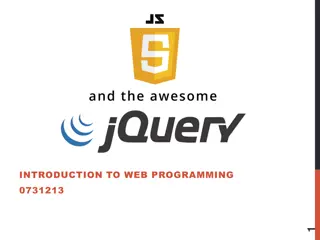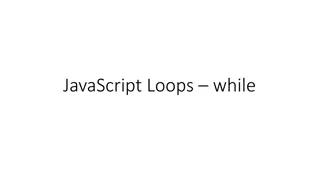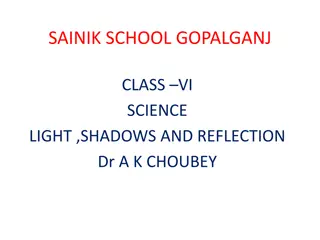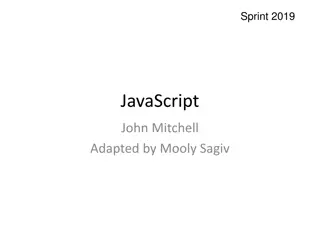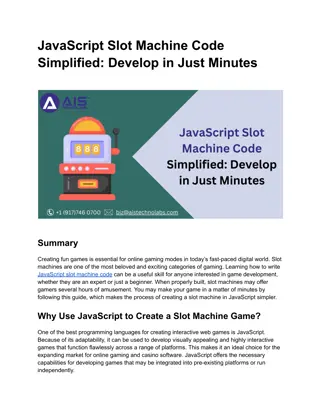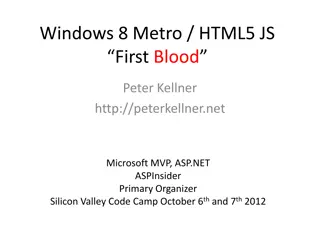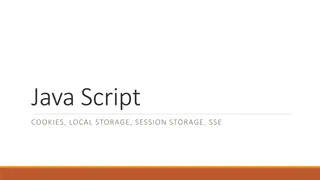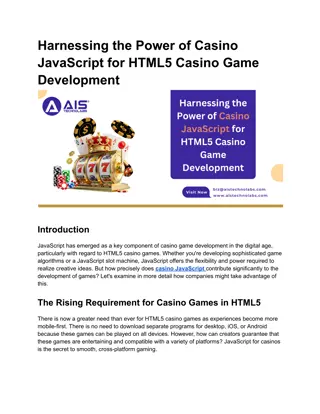Objects in JavaScript: Basics and Usage
JavaScript utilizes the concept of objects in a versatile manner, encompassing both structured data collections and object-oriented programming principles. While the terminology in JavaScript may seem imprecise compared to other languages, understanding how objects function as aggregates is crucial. This article delves into creating objects using JavaScript Object Notation (JSON) and explores the traditional view of objects as data aggregates, offering insights into their significance in modern programming practices.
Download Presentation

Please find below an Image/Link to download the presentation.
The content on the website is provided AS IS for your information and personal use only. It may not be sold, licensed, or shared on other websites without obtaining consent from the author.If you encounter any issues during the download, it is possible that the publisher has removed the file from their server.
You are allowed to download the files provided on this website for personal or commercial use, subject to the condition that they are used lawfully. All files are the property of their respective owners.
The content on the website is provided AS IS for your information and personal use only. It may not be sold, licensed, or shared on other websites without obtaining consent from the author.
E N D
Presentation Transcript
Objects In JavaScript Jerry Cain CS 106AX October 11, 2024 slides leveraged from those constructed by Eric Roberts
Contests CS106AX will have two contests as follows: The Graphics Contest associated with Assignments #2 and #3 The Adventure Contest associated with Assignment #6 The grand prize in the contest is a score of 100% on one of the graded components of the course (which in practice is almost always the final exam). As an additional incentive, entering any of the contests gives you a virtual ticket to win an additional grand prize in an end- of-quarter lottery. As does receiving a runner-up or honorable mention on a contest and finding errors and reporting in the textbooks.
Objects in JavaScript JavaScript uses the word "object" in a frustratingly imprecise way. Unsurprisingly, the word "object" is used for the encapsulated data collections one finds in the object-oriented programming paradigm, as we ll will describe more during the Python portion of the course. Unfortunately, JavaScript uses the same word to refer to any collection of individual data items. In other programming languages, such a collection is often called a "structure," a "record," or an "aggregate." We will use "aggregate" when we want to restrict objects of this more primitive form.
Objects as Aggregates Even though modern programming practice tends to favor the object-oriented model, it is still important to understand the more traditional view of objects as data aggregates. Aggregates are used to represent situations in the real world in which several independent pieces of data are best bundled into a single structure. In contrast to an array, the elements in an aggregate can be and often are of different types and are identified by name rather than by a sequence number. The first example in the text imagines keeping track of the data for the employees of Scrooge and Marley, the company from Charles Dickens s A Christmas Carol. Each employee is identified by a name, a job title, and a salary. A diagram of the two employees at the company appears on the next slide.
Employees at Scrooge and Marley name name Ebenezer Scrooge Bob Cratchit title title CEO clerk salary salary 1000 25
Using JSON to Create Objects The easiest way to create new aggregates in JavaScript is to use JavaScript Object Notation or JSON. In JSON, you specify an object simply by listing its contents as a sequence of name-value pairs. The name and the value are separated by a colon, the name-value pairs are separated by commas, and the entire list is enclosed in curly braces. The following declarations create variables named ceo and clerk for the employees diagrammed on the previous slide: let ceo = { name: "Ebenezer Scrooge", title: "CEO", salary: 1000 }; let clerk = { name: "Bob Cratchit", title: "clerk", salary: 25 };
Selecting Fields from an Object Given an object, you can select an individual field by writing an expression denoting the object and then following it by a dot and the name of the field. For example, the expression ceo.name returns the string "EbenezerScrooge"; similarly, clerk.salary returns the number 25. Fields are assignable. For example, the statement clerk.salary *= 2; doubles poor Mr. Cratchit s measly salary. Fields selection can also be expressed using square brackets enclosing the name of the field expressed as a string, as in ceo["name"]. This style is necessary if the name of the field is not a simple identifier or, more likely, if the name is computed by the program.
Arrays of Objects Since arrays can contain values of any type, the elements of an array can be JavaScript objects. For example, the employees at Scrooge and Marley can be initialized like this: let employees = [ {name:"EbenezerScrooge",title:"CEO",salary:1000}, {name:"Bob Cratchit",title:"clerk",salary:25} ]; The following function prints the payroll for the employee array supplied as an argument: function printPayroll(employees) { for (let i = 0; i < employees.length; i++) { let emp = employees[i]; console.log(emp.name + " (" + emp.title + ") " + emp.salary); } }
Representing Points as Aggregates One data aggregate that comes in handy in graphics captures the abstract notion of a point in two-dimensional space, which is composed of an x and a y component. Points can be created in JavaScript simply by writing their JSON notation, as in the following examples, which are shown along with their positions in the graphics window. Graphics Window let p1={x:0,y:0}; let p2={x:90,y:70}; The x and y components of p1 can be selected as p1.x and p1.y, respectively.
Factory Functions Although JSON notation is compact and easy to read, it is often useful to define a function that creates a JavaScript object. Such functions are called factories and are written in the book using an uppercase initial letter. The following function creates a point-valued object for which the coordinate values default to the (0, 0) point at the origin: function Point(x, y) { if (x === undefined) { x = 0; y = 0; } return { x: x, y: y }; } This x is a value. This x is a name.
Points and Graphics Points often turn up in graphical applications, particularly when you need to store the points in an array or an object. As an aesthetically pleasing illustration of the use of points and the possibility of creating dynamic pictures using nothing but straight lines, the text presents the program YarnPattern.js, which simulates the following process: Place a set of pegs at regular intervals around a rectangular border. Tie a piece of colored yarn around the peg in the upper left corner. Loop that yarn around the peg a certain distance DELTA ahead. Continue moving forward DELTA pegs until you close the loop.
A Larger Sample Run YarnPattern
The YarnPattern Program /* * Creates a pattern that simulates winding a piece of yarn * around an array of pegs at the edges of the graphics window. */ function YarnPattern() { let gw = GWindow(GWINDOW_WIDTH, GWINDOW_HEIGHT); let pegs = createPegArray(GWINDOW_WIDTH, GWINDOW_HEIGHT, N_ACROSS, N_DOWN); let thisPeg = 0; let nextPeg = -1; while (thisPeg !== 0 || nextPeg === -1) { nextPeg = (thisPeg + DELTA) % pegs.length; let p0 = pegs[thisPeg]; let p1 = pegs[nextPeg]; let line = GLine(p0.x, p0.y, p1.x, p1.y); line.setColor("Magenta"); gw.add(line); thisPeg = nextPeg; } } page 1 of 3
The YarnPattern Program /* * Creates an array of pegs around the perimeter of a rectangle * with the specified width and height. The number of pegs in /* * Creates a pattern that simulates winding a piece of yarn * around an array of pegs at the edges of the graphics window. */ * each dimension is specified by nAcross and nDown. */ function YarnPattern() { let gw = GWindow(GWINDOW_WIDTH, GWINDOW_HEIGHT); let pegs = createPegArray(GWINDOW_WIDTH, GWINDOW_HEIGHT, N_ACROSS, N_DOWN); let thisPeg = 0; let nextPeg = -1; while (thisPeg !== 0 || nextPeg === -1) { nextPeg = (thisPeg + DELTA) % pegs.length; let p0 = pegs[thisPeg]; let p1 = pegs[nextPeg]; let line = GLine(p0.x, p0.y, p1.x, p1.y); line.setColor("Magenta"); gw.add(line); thisPeg = nextPeg; } } pegs.push(Point(0, i * dy)); } return pegs; } function createPegArray(width, height, nAcross, nDown) { let dx = width / nAcross; let dy = height / nDown; let pegs = [ ]; for (let i = 0; i < nAcross; i++) { pegs.push(Point(i * dx, 0)); } for (let i = 0; i < nDown; i++) { pegs.push(Point(nAcross * dx, i * dy)); } for (let i = nAcross; i > 0; i--) { pegs.push(Point(i * dx, nDown * dy)); } for (let i = nDown; i > 0; i--) { page 2 of 3
The YarnPattern Program /* * Creates an array of pegs around the perimeter of a rectangle * with the specified width and height. The number of pegs in * each dimension is specified by nAcross and nDown. */ */ /* * Creates a new Point object. If this function is called with * no arguments, it creates a Point object at the origin. function createPegArray(width, height, nAcross, nDown) { let dx = width / nAcross; let dy = height / nDown; let pegs = [ ]; for (let i = 0; i < nAcross; i++) { pegs.push(Point(i * dx, 0)); } for (let i = 0; i < nDown; i++) { pegs.push(Point(nAcross * dx, i * dy)); } for (let i = nAcross; i > 0; i--) { pegs.push(Point(i * dx, nDown * dy)); } for (let i = nDown; i > 0; i--) { pegs.push(Point(0, i * dy)); } return pegs; } function Point(x, y) { if (x === undefined) { x = 0; y = 0; } return { x: x, y: y }; } /* Constants */ const GWINDOW_WIDTH = 1000; const GWINDOW_HEIGHT = 625; const N_ACROSS = 80; const N_DOWN = 50; const DELTA = 113; page 3 of 3
The Concept of a Map One of the most important applications of JavaScript objects uses them to associate pairs of data values. In computer science, the resulting data structure is called a map. Maps associate a simple data value called a key (most often a string)withavalue,whichisoftenlargerandmorecomplex. Examples of maps exist everywhere in the real world. A classic example is a dictionary. The keys are the words, and the values are the corresponding definitions. A more contemporary example is the World-Wide Web. In this example, the keys are the URLs, and the values are the contents of the corresponding pages.
Maps and JavaScript Objects In the context of CS 106AX, the most obvious example of a map is the JavaScript object, which precisely implements the map concept. The keys are strings, and the values are arbitrary JavaScript values. When you use an object as a map, you supply the key as a string expression using the square-bracket notation, as in map[key] If the key is defined in the map, this selection returns the value. If no definition has been supplied, the selection returns the constant undefined. Map selections are assignable, so that you can set the value associated with a key by executing an assignment statement: map[key] = value;
Iterating Through Keys in an Object One of the common operations that clients need to perform when using a map is to iterate through the keys. JavaScript supports this operation using a different form of the for statement, which has the following structure: for (let key in map) { let value = map[key]; . . . code to work with the individual key and value . . . } In JavaScript, this new form of the for loop processes the keys in any order it chooses.
